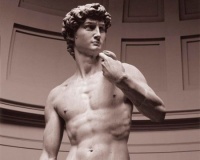David of Michelangelo (1504)
A Symbol of the Defense of Civil Liberties in the Republic of Florence[edit]
Michelangelo’s statue of David is one of the most instantly recognisable sculptures in human history. Sculpted between 1501 and 1504, David is a 5.17m statue of exceptional detail, made out of gleaming white marble. Besides holding great aesthetic value individually, it also serves as a key representation of the burgeoning Italian renaissance, although of course it is not the only monument or piece of art to hold this iconic statement. The Italian renaissance movement has been hugely pervasive in the field of art and culture and remains so to this day, not only for Italian culture specifically, but for the capabilities and expression of humankind more generally. Furthermore, David was an important figure in Florence at the time as his heroic victory over Goliath and was considered to represent the defiant defence of Florence against invaders. Beyond the religious connotation and association with Italian high culture, David also stands plainly and honestly naked, as a member of the human race. In this sense the statue of David is accessible to all cultures, not just Christian or Italian, and so draws universal interest.
